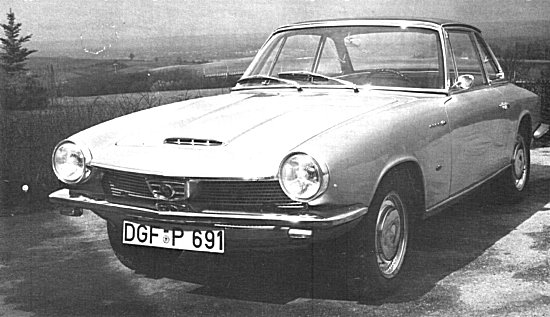Description
The Glas 1700 GT was the larger and more powerful sibling of the celebrated Glas 1300 GT, introduced in 1964 as part of Hans Glas GmbH’s attempt to move upmarket into the world of true grand touring cars. Styled by Pietro Frua, the 1700 GT shared its elegant design with the 1300 GT but distinguished itself with a bigger, more capable engine that delivered performance to match its sophisticated looks. It was offered in both coupé and cabriolet body styles, making it one of the most glamorous models ever to emerge from the small Bavarian carmaker.
The exterior design of the 1700 GT was a masterpiece of Italian influence. With its long bonnet, flowing lines, and balanced proportions, it exuded the kind of elegance usually associated with Alfa Romeo or Maserati rather than a small German manufacturer. The car’s stance was low and sporty, highlighted by a wide front grille, slim chrome accents, and carefully detailed rear lights. Whether as a coupé with its fastback roofline or as a cabriolet with its neat folding soft top, the 1700 GT projected the image of a true gran turismo.
Inside, the Glas 1700 GT reflected its position as a premium offering. The cabin layout was driver-focused, with clear instrumentation, a tachometer as standard, and controls positioned for easy access. Comfortable bucket seats, improved upholstery, and refined trim gave the car an upscale feel. Seating was arranged as a 2+2, with the rear seats suitable for children or short trips. While compact compared to larger GT cars, the Glas’s interior provided both comfort and a touch of luxury, making it a practical choice for stylish touring.
The heart of the 1700 GT was its 1,682 cc four-cylinder engine, an overhead camshaft unit driven by Glas’s pioneering toothed rubber timing belt. In its standard form, the engine produced around 100 horsepower, a substantial step up from the 75 and 85 hp variants of the 1300 GT. This gave the 1700 GT a top speed of around 175–180 km/h (109–112 mph), placing it firmly in the territory of mid-sized European sports cars of the era. Power was transmitted through a four-speed manual gearbox, and thanks to the relatively light body, the car felt lively and responsive.
On the road, the Glas 1700 GT combined smooth performance with nimble handling. The OHC engine encouraged enthusiastic driving, and while it was not as fast as six-cylinder rivals from Alfa Romeo or Porsche, it offered spirited performance in a more affordable package. The ride balanced comfort with agility, making the car well-suited to long-distance touring as well as city driving. The cabriolet version in particular offered an appealing mix of open-air motoring and technical innovation.
Despite its strengths, the Glas 1700 GT faced challenges in the marketplace. The company’s limited production capacity and dealer network meant that it could not compete in sales volume with larger manufacturers. However, the GT series played a critical role in enhancing Glas’s image, positioning it as a maker of technically advanced and stylish cars. After BMW acquired Glas in 1967, the 1700 GT was briefly rebadged as the BMW-Glas 1700 GT before being phased out, adding to its rarity.
Today, the Glas 1700 GT is highly prized by collectors for its combination of Italian design, German engineering, and historical significance. Its Frua styling gives it timeless beauty, while its advanced OHC engine underscores Glas’s role as a pioneer in modern engine technology. Rare, elegant, and innovative, the 1700 GT remains one of the standout achievements of Hans Glas GmbH and a reminder of the company’s bold ambition during its final independent years.
